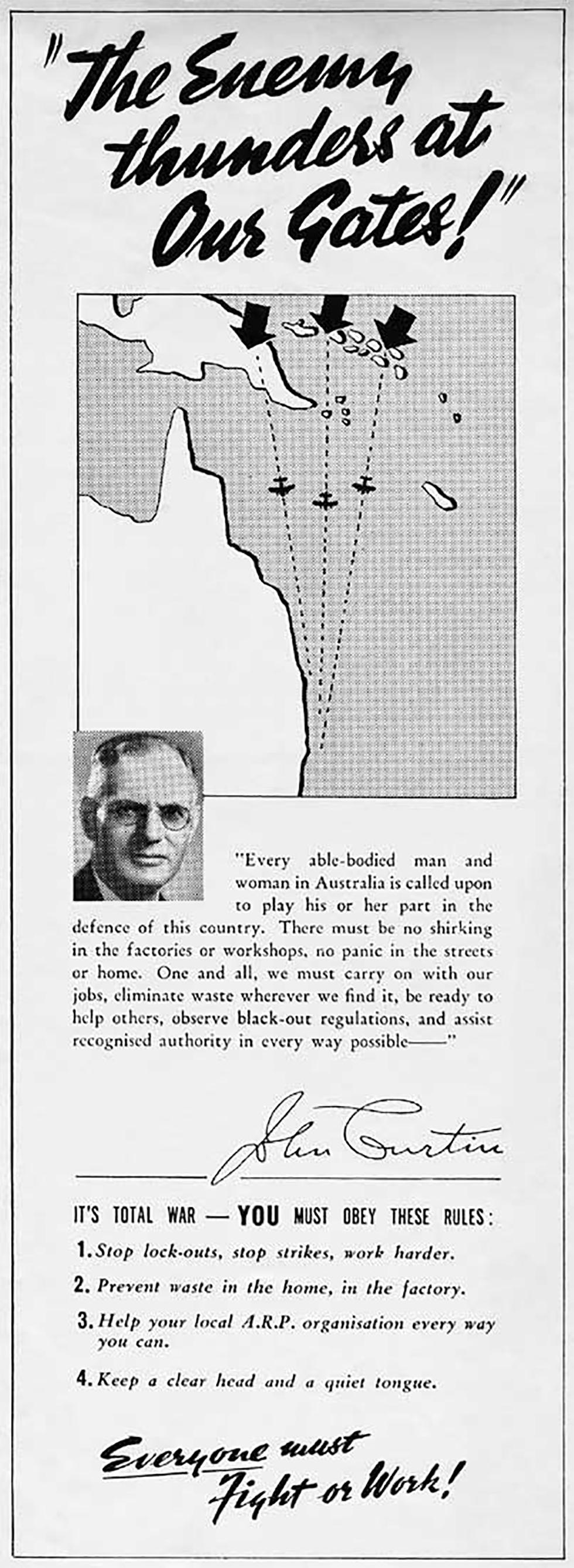


Transcript
[Heading, bold and italicised:] "The Enemy thunders at Our Gates!"
[A black and white map showing Papua New Guinea and the north-east coast of Australia. Three black planes are travelling along dotted lines from Papua New Guinea to the east coast, with large black arrows pointing to their places of origin.]
[Overlapping with the bottom left corner of the picture, a black and white photo of Prime Minister John Curtin]
"Every able-bodied man and woman in Australia is called upon to play his or her part in the defence of this country. There must be no shirking in the factories or workshops, no panic in the streets or home. One and all, we must carry on with our jobs, eliminate waste wherever we find it, be ready to help others, observe black-out regulations, and assist recognised authority in every way possible – "
[Large handwritten signature:] John Curtin
[dividing line]
IT'S TOTAL WAR – YOU [word bolded] MUST OBEY THESE RULES:
1. Stop lock-outs, stop strikes, work harder.
2. Prevent waste in the home, in the factory.
3. Help your local A.R.P. [Air Raid Precautions] organisation every way you can.
4. Keep a clear head and a quiet tongue.
[Large bold, italicised text:] Everyone [underlined] must Fight or Work!
About this record
This is a black-and-white poster showing a map of Australia with arrows and planes coming down from Papua New Guinea and the headline 'The Enemy thunders at Our Gates'. There is a photo of Prime Minister John Curtin and a message from him, calling on Australians to play their part in the war effort.
Educational value
- Is an example of a poster being used to deliver war messages from the Australian Government to its citizens during the Second World War (1939–45) – in 1939 Australia entered the war, declaring war on Germany, and then in 1941 declared war on Japan.
- Illustrates the Japanese threat to Australia, indicated by the arrows and planes pointing down from Papua New Guinea and the Solomon Islands – in 1941 Japan launched a campaign to conquer the Pacific region, invading Hong Kong, the Philippines, Malaya, Singapore and New Guinea, and from 1942 bombing Darwin and other Australian towns, killing 243 people.
- Refers to the second phase of Australia's participation in the Second World War – in the first phase, Australia joined British troops in the fight against Germany, which was identified as the primary enemy; in the second phase of the war, Australia's main efforts went to fighting the Japanese.
- Quotes John Curtin, who served as Prime Minister of Australia from 7 October 1941 to 6 July 1945 – in 1942 he brought Australian troops back to defend Australia despite British orders to send them elsewhere, an act that was seen as a move away from Britain; Curtin then increasingly looked to the USA for help to defend Australia.
- Indicates that the war dominated and regulated everyday life in Australia – messages such as 'YOU MUST OBEY THESE RULES' and 'Everyone must Fight or Work!' show that Australians were being asked to make personal sacrifices for the war effort; this personal endeavour was known as 'All in'.
- Indicates that ordinary Australians were expected to support Australia's war effort by working harder and not 'shirking' or taking industrial action – during the war the Australian Government took control of the labour force, fixing wages and conditions.
- Reveals an atmosphere of fear and distrust on the home front – Australians are urged to 'keep a quiet tongue', meaning that they should be wary of communicating information that might be useful to the enemy, in case spies are listening.
- Is an example of the work of the Commonwealth Advertising Division, set up in 1941 within the Department of Information to assist in the war effort – in this case, the poster is delivering the Prime Minister's message to the people of Australia.
- Urges Australians to help the ARP in every way – Air Raid Precautions (ARP) was the civil defence organisation in Australia during World War II – both women and men served as ARP wardens.
- Is an example of historical context giving meaning to a graphic image – because of the events of 1941, when Japan's plans to attack Australia were well known, most Australians would immediately recognise the arrows and planes heading for Sydney as symbols of a Japanese invasion.
Acknowledgments
Learning resource text © Education Services Australia Limited and the National Archives of Australia 2010.
Need help with your research?
Learn how to interpret primary sources, use our collection and more.

